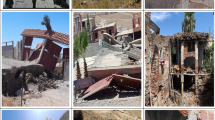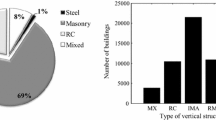Abstract
After an earthquake, many field investigations are conducted to classify the damage undergone by the buildings. In many cases, it has been found that the global damage category (DG) assigned to the construction does not correspond to the damage associated with the building various components (bearing elements, non-bearing elements, infrastructure, environment, etc.). In this paper, a method for the quantitative evaluation of post-earthquake damage of buildings is developed, based on the theory of the experimental design. This study has been conducted by processing a database of 7.847 damaged buildings extracted from a database collected during a post-earthquake survey (Boumerdes, Algeria, 2003 earthquake). In doing so, firstly, two mathematical models have been developed to quantify the two quantities that assess the state of all the bearing and non-bearing elements (DER) and (DES) respectively. Then, a function representing the relationship between the severity of the element-scale damage and the global damage category of the building was developed. Finally, an application of the proposed method has been performed on a set of ten damaged buildings. The results indicate that the proposed method provides a more accurate assessment of the condition of the building compared to the decisions made by the engineers during the Boumerdes earthquake inspection in 2003.












Similar content being viewed by others
References
Agnastopoulos SA, Moretti M (2008) Post-earthquake emergency assessment of building damage, safety and usability. Part 1: technical issues. Soil Dyn Earthq Eng 28(3):223–232
Akkouche K, Hannachi NE, Hamizi M, Khelil N, Djouzi K, Daoui M (2019) Knowledge-based system for damage assessment after earthquake: Algerian buildings case. Asian J Civ Eng 20(2):769–784
Applied Technology Council (ATC) (1989) Procedure for post-earthquake safety evaluation of buildings. ATC 20. Redwood City, CA
Applied Technology Council (ATC) (2005) Field manual: post-earthquake safety evaluation of buildings, 2nd edition, ATC-20-1, Redwood City, CA
Baggio C, Bernardini A, Colozza R, Corazza L, Della Bella M, Di Pasquale G, Dolce M, Goretti A, Martinelli A, Orsini G, Papa F, Zuccaro G (2007) Field manual for post-earthquake damage and safety assessment and short term countermeasures. ISSN 1018-5593
Bertero V, Shah H (1983) El-Asnam, Algeria earthquake of October 10, 1980: a reconnaissance and engineering report. Report EERI
Boukri M, Farsi MN, Mebarki A, Belazougui M, Amellal O, Mezazigh B, Guessoum N, Bourenane H, Benhamouche A (2014) Seismic risk and damage prediction: case of the buildings in Constantine city (Algeria). Bull Earthq Eng 12(1):2683–2704
Carreño ML, Cardona OD, Barbat AH (2010) Computational tool for post-earthquake evaluation of damage in buildings. Earthq Spectra 26(1):63–86
Carreño ML, Cardona OD, Barbat AH (2011) Evaluation of the habitability of buildings affected by an earthquake using the fuzzy sets theory and the artificial neural networks. Revista Internacional de Métodos Numéricos para Cálculo y Diseño en Ingeniería 27(4):278–293 (exists in Spanish)
Coburn AW (1989) Seismic vulnerability and risk reduction strategies for housing in Eastern Turkey. Dissertation for Ph.D., Univ. of Cambridge, pp 1–212
Dagnelie P (2000) La planification des expériences: choix des traitements et dispositif expérimental (avec discussion). J Soc Franç Stat 141(1–2):5–69
Dandoulaki M, Panoutsopoulou M, Ioannides K (1998) An overview of post- earthquake building inspection practices in Greece and the introduction of rapid building usability evaluation procedure after the 1996 Konitsa earthquake. In: Proceedings XI european conference on earthquake engineering, Balkema, Rotterdam
Davidoviči V (2003) Rapport de mission (séisme de Boumerdes). Ministère de l’habitat et de l’urbanisme ministère de l’aménagement du territoire et de l’environnement
Goretti A (2001) Post-earthquake building usability: an assessment. Technical report SSN/RT/01/03, Italy
Goretti A, Pasquale GD (2004) Building inspection and damage data for the 2002 Molise, Italy, Earthquake. Earthq Spectra 20(S1):167–190
Goupy J (1990) Étude comparative de divers plans d’expériences. Revue Stat Appl 38(4):5–44
Goupy J (2000) Modélisation par les plans d’expériences. Techniques de l’Ingénieur, R275
Goupy J, Creighton L (2006) Introduction aux plans d’expériences, 3ème édition. DUNOD. ISBN 2-10-049744-8
Grünthal G, Levret A (2001) European macro-seismic scale 1998 (EMS-98). Cahiers du Centre Européen de Géodynamique et de Séismologie. Luxembourg: Conseil de l’Europe. 19. (exists in English)
HAZUS. Federal Emergency Management Agency, FEMA (2002) HAZUS99: earthquake loss estimation methodology. Technical manual. Washington, DC
Kaveh A, Mahdavi VR (2016) Damage identification of truss structures using CBO and ECBO algorithms. Asian J Civ Eng 17(1):75–89
Masi A, Santarsiero G, Digrisolo A, Chiauzzi L, Manfredi V (2016) Procedures and experiences in the post-earthquake usability evaluation of ordinary buildings. Boll Geofis Teor Appl 57(2):199–220
Maskri B, Attar A, Breysse D, Bourahla N (2009) Modélisation de la réponse sismique des structures par la méthode des plans d’expériences: cas des bâtiments de forme régulière. Eur J Environ Civ Eng 13(3):329–346
Noura H, Mebarki A, Abed M (2017) Post-quake structural damage evaluation by neural networks: theory and calibration. Eur J Environ Civ Eng. https://doi.org/10.1080/19648189.2017.1304277
Okada S, Takai N (2000) Classifications of structural types and damage patterns of buildings for earthquake field investigation. In: Twelfth world conference on earthquake engineering, Auckland, pp 1–8
Olson DL, Dash WuD (2010) Earthquakes and risk management in China. Hum Ecol Risk Assess 16(3):478–493
Plackett RL, Burman JP (1946) The design of optimum multi-factorial experiments. Biometrika 33(4):305–325
Rechtschaffner RL (1967) Saturated fractions of 2 and 3 factorial designs. Technometrics 9:569–575
Rout S, Nanda RP, Panda KC (2015) Seismic damage evaluation of existing buildings based on shear wave velocity: a case study’s. Asian J Civ Eng 16(6):909–918
Schimmerling P, Sisson JC, Zaidi A (1998) Pratique des plans d’expériences. Tec & Doc Lavoisier, France
Sinha R, Shiradhonkar SR (2012) Detailed evaluation of available seismic damage indices. In: ISET golden jubilee symposium, Indian Society of Earthquake Technology
Souvay P (2002) Plans d’expériences - Méthode Taguchi. AFNOR, Paris
Taguchi G, Konishi S (1987) Taguchi methods, orthogonal arrays and linear graphs, tools for quality engineering. American supplier Institute, Dearborn, pp 35–38
Tebbiche H, Boutoudj MS (2014) Optimized vortex generators in the flow separation control around a NACA 0015 profile. In: 9th International conference on structural dynamics, EURODYN 2014, Porto, pp 3219–3226
Telforda JK (2007) Brief introduction to design of experiments. Johns Hopkins Apl Tech Dig 27(3):224–232
Tinsson W (2010) Plans d’expérience: constructions et analyses statistiques. Collection Mathématiques et Applications, vol 67. Springer, Berlin
Tiziana M (2008) Comparison of building damage scales and damage descriptions for use in earthquake loss modelling in Europe. Bull Earthq Eng 6:335–365
Vidal F, Feriche M, Ontiveros A (2009) Basic techniques for quick and rapid post-earthquake assessments of building safety. In: 8th international workshop on seismic micro zoning and risk reduction, Almería
Acknowledgements
The authors would like to thank the Algerian institution (the National Earthquake Engineering Research, CGS, Algeria) which made available a part of their database. In particular the scientific staff: Mehdi BOUKRI, Mohammed-Naboussi FARSI, Mohamed BELAZOUGUI.
Author information
Authors and Affiliations
Corresponding author
Additional information
Publisher's Note
Springer Nature remains neutral with regard to jurisdictional claims in published maps and institutional affiliations.
Rights and permissions
About this article
Cite this article
Akkouche, K., Hannachi, N.E., Hamizi, M. et al. Development of a relation model for global and local damage categorization: the case of the Algerian building. Bull Earthquake Eng 18, 3057–3077 (2020). https://doi.org/10.1007/s10518-020-00810-6
Received:
Accepted:
Published:
Issue Date:
DOI: https://doi.org/10.1007/s10518-020-00810-6




